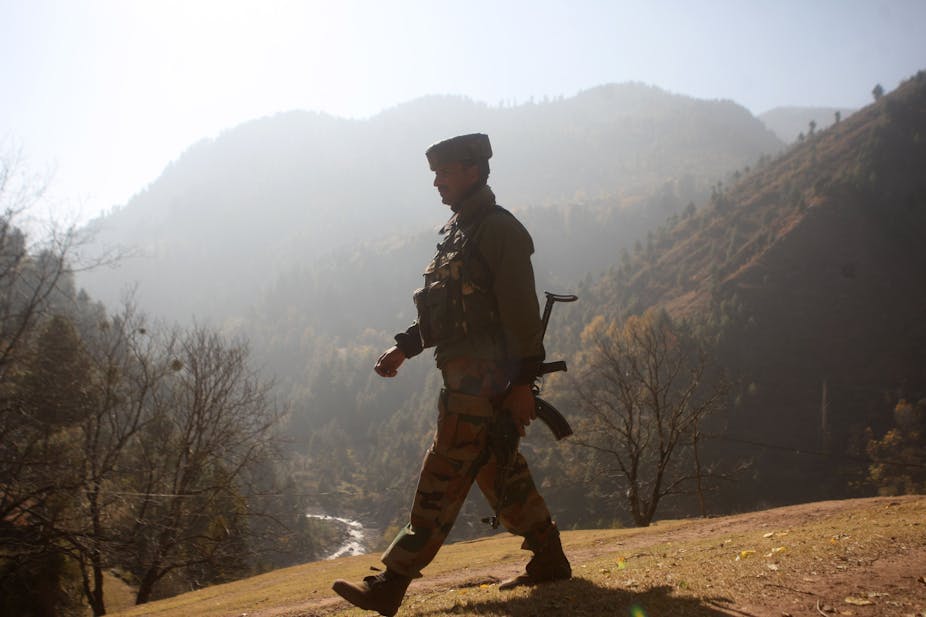In the coming days, India’s new prime minister, Narendra Modi, will have to set out exactly how he plans to fix the economy and address many domestic issues. But politics doesn’t stop at the border. Modi’s foreign policy challenges include India-US relations, the two Asian giants China and Japan, and how to deal with Pakistan.
Some changes can be expected. In its manifesto, the BJP states it will develop a “web of allies” to further India’s interests, that it will be “zero tolerance” on terrorism, and it pledges to reconsider the nuclear doctrine of “no first use”.
So how will these ideas work in practice? Let’s start with Modi and the BJP’s likely stance towards India’s most crucial ally: the US.
American allies
Under the last BJP-led government in 1998-2004, then prime minister, Atal Bihari Vajpayee, laid the foundations for a strategic partnership with the US. The two countries saw common strategic goals: the security threat from Islamic terrorism, and the shifting balance of power in Asia as China’s military became more powerful. The outgoing Congress prime minister, Manmohan Singh, continued this trend, and concluded the US-India nuclear deal and a ten-year defence pact.
However, rows over the arrest and strip search of Indian diplomat Devyani Khobragade – and the fact Modi – was once denied entry to the US, have led many to question the future of Indo-US ties.
Now that the BJP is back in power though, will ties with the US strengthen? India has certainly drawn closer to the West politically in the past two decades and Modi and BJP’s business friendliness should see economic and strategic engagement with the US and the Western develop too. Barack Obama, for one, has clearly stated that America would like to do business with the new government.
The US-India relationship is entwined with the values and principles of democracy backed by strategic and economic realities of the 21st century. Preventing China dominating Asia will remain a major aim of the world’s two largest democracies. The two nations are natural allies and the stakes are too high for them to not fix their strategic partnership.
Looking East
Another big question concerns “Look East”, a strategy followed since the early 1990s which seeks to boost India’s role in Asia and to counter Chinese power. Many feel the BJP may view Look East in terms of Hindu civilisational links, where the focus would be on enhancing the cultural links with those countries which have Hindu or Buddhist religious heritage.
The “web of allies” might also see Modi boost relations with Japan, as he has a good relationship with the Japanese prime minister, Shinzo Abe. Even when Modi was banned from the US for his failure to tackle riots in Gujarat, Abe still invited him to Japan. India’s incoming leader visited Japan once in 2007 when Abe was in power and again in 2012, back when Abe was in opposition.
Both India and Japan have worked in recent years to build strong economic and strategic ties. Japan fits into India’s strategic priorities regarding cultural links, economic development and the broader Asian balance of power. China’s aggressive military posture concerns both countries.
India has been at odds with China since war in 1962, and border disputes continue to prevent improved relations. It is likely that Modi, a economic performer who would like to enhance India’s trade ties with its near neighbours, might adopt more pragmatic posture even towards China. In case of any misadventures by China or Pakistan, Modi, who is also a nationalist and hardliner will not continue with strategic restraint.
What of Pakistan?
Looking West, dialogue with Pakistan depends on whether Pakistan is sincere about stopping cross-border terrorism and support for terrorism in India. The latest National Bomb Data Centre statistics show only Iraq and Pakistan suffer more bombings than India.
In the late 1990s and early 2000s, Vajpayee sought to ease the relationship with Pakistan through major summits and “bus diplomacy”. If Pakistan really does address India’s security concerns, the Modi government could take some historic steps to improve relations. It may even be able to tackle the most stubborn problem of all: Kashmir.
However, this will also depend on how Pakistan’s friendship with China evolves. More than half of China’s arms exports currently go to Pakistan – an obvious source of alarm for India.
In this context, it makes sense for India to maintain its good relationship with Russia. Russia is still India’s largest defence partner and, along with Japan, the only country with which India holds summit level meetings every year.
Full-spectrum strategy
Since the 1990s India has made resolute efforts to redefine its foreign policy. This has included reordering India’s relationship with the US, enhancing economic ties with developed nations in the West and linking with its immediate neighbours in South Asia. Its full-spectrum strategy to address issues in the sensitive relations with China and Pakistan, its profile in Africa and Latin America and the Middle East and its expansion eastward towards the Asia-Pacific are commendable. Both Congress and BJP seem to have been working in the same direction.
But the BJP is a revivalist party with the goal of leading India to achieve its rightful place in the world through the centuries-old tradition of “Vasudhaiva Kutumbakam” (the world is a family). The party’s emphasis on creating a “web of allies” and its rethink of the no-first-use nuclear doctrine are realist foreign policy ideas, designed to deal with geostrategic threats in its neighbourhood. Modi comes with a reputation as an economic performer and a hardline nationalist and he will try to live up to both the expectations. Under the BJP, both economic interdependence and realism will be hallmarks of Indian foreign policy.

